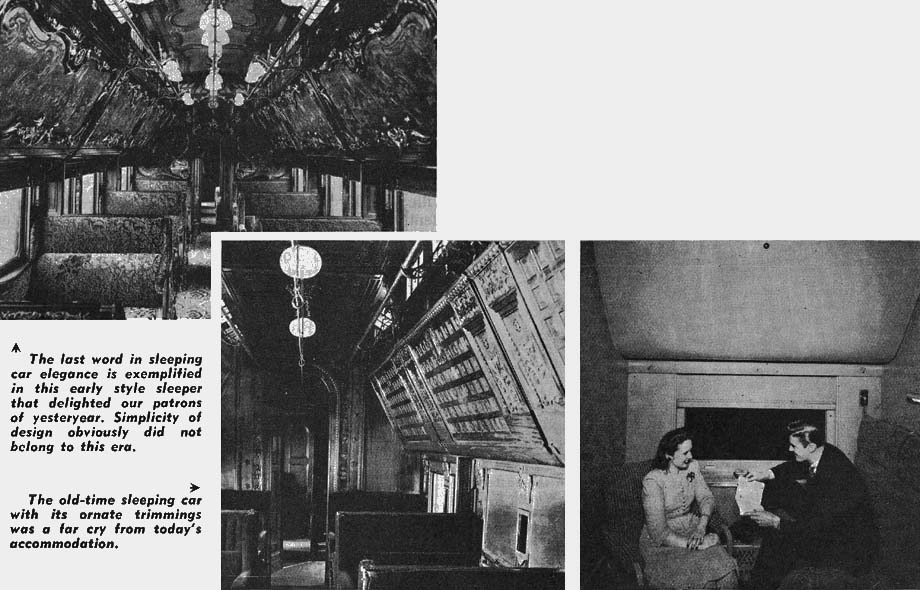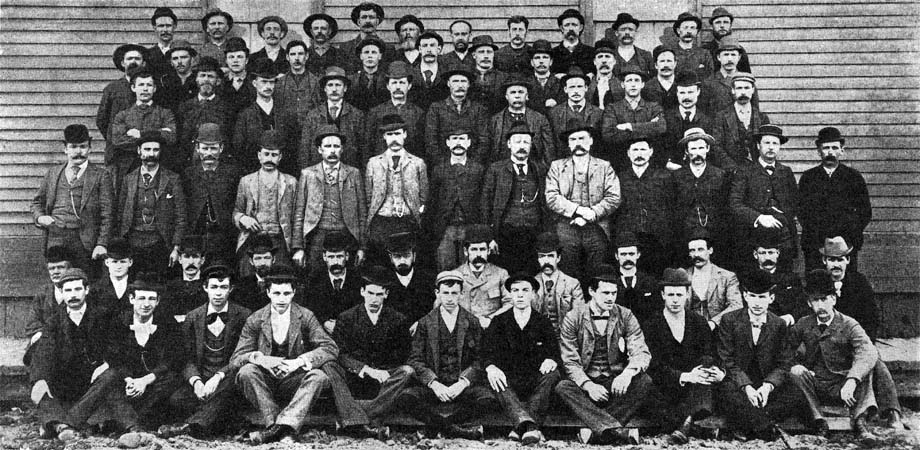
February - 1949
Last Word in Luxury
Taste of Designers Ran to Extremes in Ornate Trimmings and Rich Design

"Luxurious travel by solid express trains with palace sleeping cars attached."
This is how the Company advertised its modern fleet of sleeping cars back in 1884. Highly ornate, with rich carvings, elaborate fittings, and mahogany finish, the cars were the last word in comfort and beauty for a generation getting its first taste of sleeping car travel.
Back in the eighties it was the custom for railroads to let other companies have the franchises for telegraph, express, and sleeping car facilities. However, Sir William Van Horne, general manager and later the second president of the C.P.R., would have none of it. Why let other firms take the cream, he said, and leave the skim milk to the railway?
Cheap to Build
By the end of 1884, before the C.P.R. had pushed through to the Pacific Coast, there were 19 first class sleeping cars, 22 immigrant sleeping cars, nine parlor cars, and one dining car in service. Today there are close to 700, a total of 460 sleepers, 220 of them with a majority of open space accommodation, 154 tourist sleepers, and 86 with all-enclosed space. Parlor cars number 76, dining or commissary cars 79, business cars 52, and miscellaneous 28. Buffet or cafe service is provided on 57 of the system's parlor or sleeping cars.
The early cars were imported from the United States, and in spite of their vast amount of gingerbread
fretwork and velvet tassels, they were cheap to build. In 1882 a sleeping car cost $11,800, in 1885 a dining
car $10,000 and in 1883 a parlor car $8,824, modern C.P.R. cars run to about $175,000, $140,000 and $135,000
respectively.

One of the earliest recorded excursions over the C.P.R. line in the West was the "British
Association in Canada" trip from Winnipeg to Kicking Horse Pass in 1884, before completion of the rail link
with the East. Much study of natural history was done, and the conductors on the train apparently had their
worries with the heaps of specimens in the cars, gophers, ptarmigan, and so forth, which the
traveller-scientists collected to be skinned and mounted.
The sleeping car porter, who took no chances on his patrons missing the beauties of the mountains, awoke them one morning with the announcement: "Rocky Mountains, gentlemen. All lovely outside. Breakfast in 20 minutes."
The character of the road's territory, to some extent, rendered sleeping and dining cars as essential as coaches. Van Home took special interest in designing cars so that they should furnish the maximum of comfort and offer what was then considered to be an aesthetic appeal.
He engaged artists for interior decoration, supplementing or modifying their designs in accordance with dictates of his own taste. Illustrating with a sketch the discomfort of a tall and fat man drawn up in one of the short berths then used on American roads, he had the Canadian Pacific sleeping cars built higher and wider, and equipped with longer and wider berths.
Considerable excitement was caused by the departure, in 1886, of the first through passenger train to the Pacific from Montreal's old Dalhousie Station. It was made up of first class coaches, colonist cars, a dining car and two sleeping cars appropriately named Yokohama and Honolulu. A reporter of the day valued the diner's silverware at $3,000 and said that the sleepers were equipped with baths "to attract Oriental travel".
By 1889 sleeping cars were operated between Montreal and Boston, Saint John, N.B., Quebec, Ottawa, Toronto, St. Paul, Minnesota, and Vancouver, between Toronto and Ottawa, North Bay and Vancouver. Parlor cars were in service between Montreal and Boston, Quebec, Ottawa and Toronto, and between Toronto and Owen Sound for connection with Great Lakes steamers.
Diners "Beyond Comparison"
The Company was pretty proud of those early cars. The system timetable for 1889 describes them as follows:
"The sleeping and parlor cars are owned and operated by the company and no expense has been spared to make them perfect. They are finished outside with polished mahogany, and their interiors, with their rich carvings and beautiful fittings, are beyond comparison. The berths are wider and longer than in other sleeping cars. The curtains, blankets, and linen, made expressly for the company, are of the finest quality. The sleeping cars are provided with bathrooms, and the sleeping and parlor cars are specially constructed so as to enable passengers to view the scenery passed."
Colonist cars, too, were "bright and pleasant, and so comfortable that they are largely used by first class passengers in making short trips. Colonists on transcontinental trains can procure mattresses, curtains, and blankets from the company, suitable for these cars, at cost price."
Early dining cars, it was claimed, were "beyond comparison in style and finish where travellers will find all the delicacies of the season at their demand for the nominal charge of 75 cents per meal."
In 1886, primarily to provide meals for train passengers as the first Rocky Mountain grades were too heavy to justify the hauling of dining cars, the C.P.R.'s first hotels were opened at Field, Glacier, Revelstoke, and North Bend in British Columbia. Later, however, grade reduction enabled diners to be carried right through, on the Trans-Canada Limited by 1907, and the Imperial Limited by 1910, and the four hotels were closed.
Those were the days of real trenchermen. A Christmas Day C.P.R. dining car menu in the early years of the century offered a seven-course dinner for $1.00, highlighted by such ambrosial items as Malpecque oysters, green turtle soup, and roast wild duck. Pommery extra dry champagne sold for $3.50 a quart and cocktails for 20 cents.
Commercial Travellers Fared Well
In the early years of the C.P.R. an unusual feature was special commercial travellers' trains, with box cars equipped with shelving and tables for the display of sample goods, and of course, sleeping and dining cars for the drummers. Each representative was entitled to half a box car, and to use space on the outside of his end of the car for advertising.
Forerunner of the tremendous troop movements of the later conflicts, the first Canadian Pacific troop trains were constructed at Perth, Ontario, and placed in service in 1884 to carry soldiers to the Northwest Rebellion on the prairies. These troop trains were the first over the line north of Lake Superior, the last spike of this section being driven 16 May 1885 by Col. W.R. Oswald of the Montreal Light Infantry.
During World War II, 11,000,000 meals were provided for service personnel in regular diners and in specially developed commissary cars from which the food was taken to the rest of the train.
Records of the C.P.R.'s sleeping, dining, and parlor car department (which has operated as a separate unit since the first transcontinental passenger train went through in 1886) show how current events have been reflected in other ways.
In 1907, when the heaviest movement of settlers to the West was under way, there were 198 colonist cars in operation, mainly on special through trains from the port cities.
(Continued on page 34)
Unfortunately, page 34 for this article was missing.


 and is reprinted here with their permission. All photographs,
logos, and trademarks are the property of the Canadian Pacific Railway Company.
and is reprinted here with their permission. All photographs,
logos, and trademarks are the property of the Canadian Pacific Railway Company.